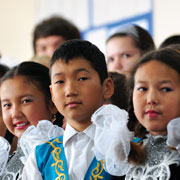Human capital
Conclusion
- Details
- Human capital
In many transition countries the stock of human capital educated to secondary level or higher is nominally on a par with, or above, most mature market economies. However, there are large differences in the quality of human capital across the transition region. A few countries (such as Estonia, Hungary, Poland and Slovenia) appear to be relatively close to the mature market economies, while others (including most countries in Central Asia) lag far behind. Countries in the SEMED region tend to be somewhere in the middle. Thus, many transition and SEMED countries risk being left behind. Only a few transition and SEMED countries – and also Turkey – have increased their international competitiveness in terms of education and research.
How can more countries catch up in this respect? This chapter has presented a number of measures that policy-makers can use to benchmark primary, secondary and tertiary education in their countries. At the same time, the regressions suggest that the quantity and quality of education are not all that matter when building an effective stock of human capital. Economies with better economic and legal institutions which are open to new ideas and global markets use their human capital in a more efficient way. This also means that they can provide high-skilled workers with higher returns and therefore deter brain drain.
Governments must provide a good regulatory framework to ensure excellence in the fields of research and teaching. They also need to recognise the relevance of specific skills, particularly at secondary and vocational levels.
A higher proportion of educated people does not necessarily lead to faster economic growth if the skills acquired during schooling do not match employers' needs. Better communication and cooperation between the private sector and universities would be beneficial and should be encouraged. Similarly, governments should not subject universities to political interference, which may deter creativity and trigger brain drain. They should provide adequate funding.
Policy-makers must also realise that having weak economic institutions and lagging behind in terms of economic reform will impede the development of human capital. Improved institutional environments are necessary to develop, attract and retain high-skilled people who will innovate, adapt to global technological changes and promote economic growth.
The stock of human capital tends to improve slowly, while brain drain may rapidly reduce it. Nevertheless, institutions can sometimes change quickly for the better through political or economic reform. They can influence the creation of human capital because they determine what returns to education people can expect. Institutions can also affect growth by determining how the existing human capital stock is used and by influencing migration flows. Developing human capital and improving institutions in transition economies are therefore complementary strategies. They reinforce each other, and they should therefore be pursued in parallel.













